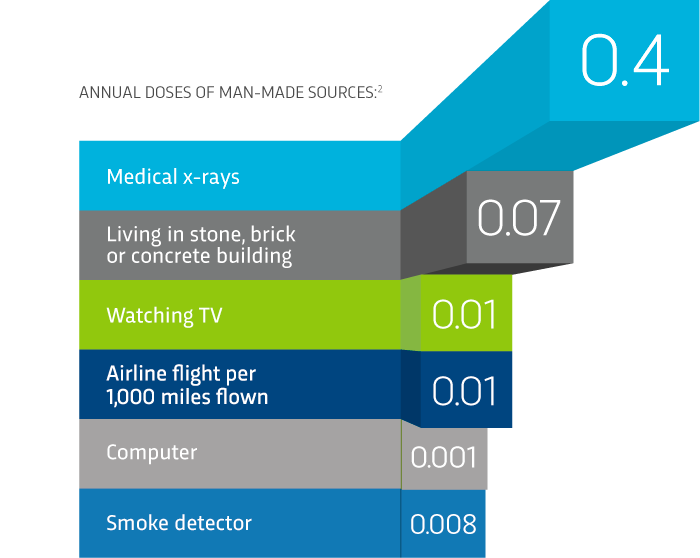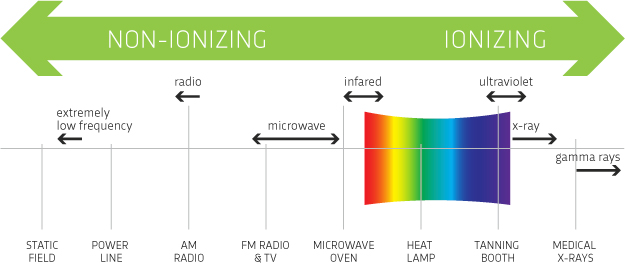
FAQs
What is a Class 1B nuclear substance processing facility?
For an accurate description of a Class 1B facility, we invite you to visit this Government of Canada description at http://laws-lois.justice.gc.ca/eng/regulations/SOR-2000-204/FullText.html.
What are sources of radiation?
Did you know?
Worldwide, the average person receives a 2.4 mSv dose of naturally-occuring radiation annually.1

2U.S. Environmental Health Protection Agency
What is radiation and where does it come from?
Types of Radiation
Radiation comes from atoms. An atom may undergo a transformation naturally or artificially. During this process, it emits energy in the form of a wave (ray) or particles.
This energy produced is known as radiation. Radiation has a wide range of energies and forms the electromagnetic spectrum. The spectrum has two major divisions:
- Non-ionizing Radiation. Non-ionizing radiation has enough energy to move atoms in a molecule around or cause them to vibrate, but not enough to remove electrons. Some of this radiation does have enough energy to cause other effects that can be harmful. Examples of this kind of radiation include sound waves, visible light, and microwaves.
- Ionizing Radiation. Ionizing radiation, the type of radiation familiar to most people, has enough energy to remove tightly bound electrons from atoms. Benefits include the generation of electric power, radiation therapy to kill cancer cells, and in diagnostic radiology such as nuclear medicine.
Ionizing radiation has two main components: Short-wave-length electromagnetic radiation (X-rays and gamma-rays) and subatomic particles (usually, alpha particles, electrons, positrons, and neutrons). Ionization, the process whereby a tightly bound electron is removed from an atom, occurs when a neutral atom has an interaction with a passing charged particle, gamma photon, positron, or electron that causes one or more of the orbital electrons of the atom to be ejected, leaving the atom charged.
The energy of the radiation shown on the electromagnetic spectrum increases from left to right as the frequency rises.

Exposure To Ionizing Radiation
Exposure to ionizing radiation can be produced by naturally occurring or man-made sources. The Canadian Nuclear Safety Commission (CNSC) has instituted a limit of 1 milliSievert (mSv) of ionizing radiation exposure over a one-year period to members of the public who are occupationally exposed. The 1 mSv limit is based on international recommendations. (It does not account for exposure from natural radiation sources or medical diagnosis or treatment.) Visit the CNSC website for additional information on its programs.
Natural Background Radiation
It’s important to remember that we are continually exposed to ionizing radiation from natural sources. The main constituents of this natural background radiation are:
- Cosmic rays from outer space which reach the Earth
- Radioactive substances in the Earth’s crust
- Trace amounts of radioactivity in the body
When the Earth was formed, many of its elements were radioactive. Over the millennia, radioactivity decayed until only those isotopes with extremely long half lives of 100 million years or more and their decay products are found in the Earth’s crust. The following table lists the estimated average annual effective doses of radiation from natural sources.
How does a gamma irradiator work?
The best way to answer this question is to see one work. This video shows food being irradiated to reduce micro-organisms.
Here’s a description of what you’ll see in this animation. Products are loaded into totes for irradiation. These products can be medical devices, consumer products or food products such as spices, meats, fruits or vegetables. The totes enter the shielded irradiation room through a maze in the concrete, then the totes are indexed around a source of radiation. The radiation from the source penetrates through the totes to deliver the required amount of energy to the entire product. The shielded concrete walls absorb any remaining energy. The product never comes into contact with the source, and the energy from the source cannot make the products radioactive. Once the totes have traveled the full distance around the source and out the exit maze, the products can be safely unloaded and are ready to be shipped to the end user.
What do you think
Your responses to this 5-minutes survey will help us to further refine our communications to the communities in which we live and work.

